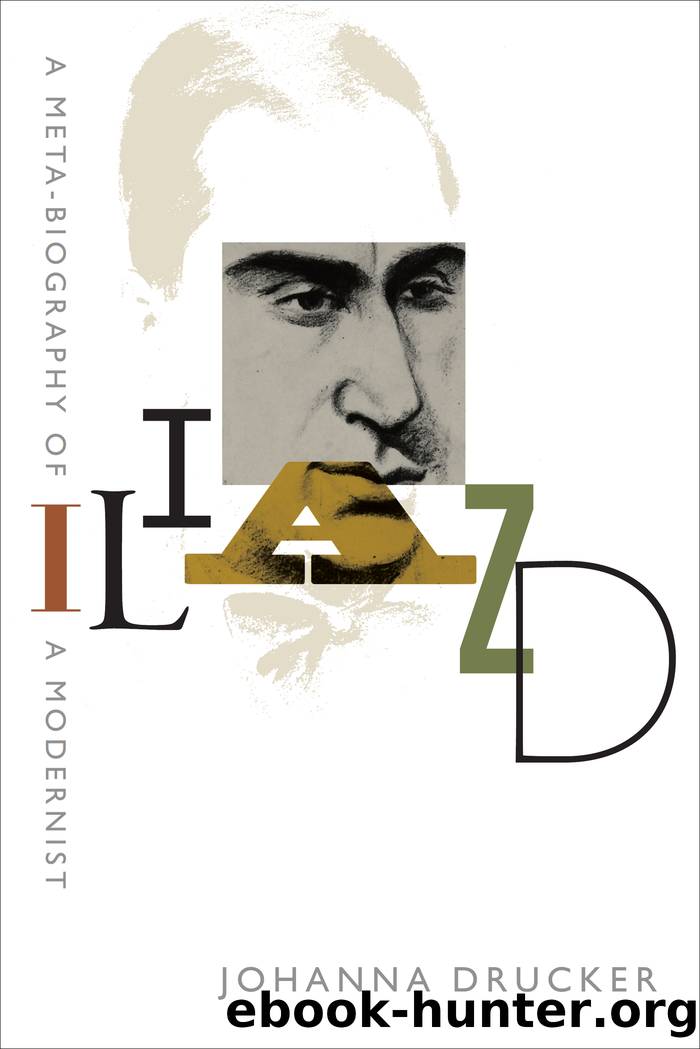Iliazd by Johanna Drucker

Author:Johanna Drucker
Language: eng
Format: epub
Publisher: Johns Hopkins University Press
Published: 2020-02-14T16:00:00+00:00
Changes of Circumstances and New Books
Iliazdâs work with Chanel continued until December 1933, but increasingly the Depression made the factory economically unfeasible. During Iliazdâs last year in the position, the letters exchanged between him and the director of Chanelâs operations, Paul Iribe, showed Iliazdâs repeated attempts to prevent layoffs for the workers he supervised. Nevertheless, cutbacks continued, and Iliazd wrote the final report on the plant as he himself was being terminated. He returned to Paris from the suburbs, and life was difficult. He found work intermittently and relied on the hospitality of friends for shelter. He pawned a few itemsâa vacuum cleaner, a brooch, and other things. The receipts remained among his papers, showing he had not redeemed the pawned items. In June 1934, he wrote to Axel saying with relief, âAt last, a bed!â His circumstances were never easy, and often difficult, as in this period. Work was hard to find, and skilled though he was, he struggled. Again, there is the question of the childrenâs whereabouts.
In spite of these limitations, he pursued projects and plans. A Russian theater director, Nikolai Evreinov, contacted him a few times to discuss a possible production of Yanko, or perhaps The Rapture. A new exhibition of work done for the expedition led by Professor Takaishvili years earlier contained drawings by Iliazd, and he was able to see them appreciated. He had elaborate exchanges with booksellers dealing in the architecture and archaeology of Asia Minor and Greece as he developed his studies of Byzantine churches. He corresponded with the director of the Museum of Fine Arts in Istanbul, M. Halil Edhem Eldem, on points concerning an ancient palace that had once existed near the site of Hagia Sophia. In 1934â35 he obtained a library card for the Bibliothèque St. Geneviève and occasionally earned money doing commissioned research. He collaborated with a Mr. H. Kazandjian on an article on the âStar Shaped Edifices of Armenia.â These succinct statements each indicate work and labor as well as social networks of communication and correspondence, but what they felt like on a day-to-day basis is hard to imagine. How was he paying bills and managing to keep his household afloat?
In 1935 he wrote an article titled âParis Fashion for the Year 1935,â stressing the strong blow struck to the world of fashion by the Depression. He was finally reduced to going on unemployment. A card dated 1936 entitled him to âa meal for 3 francs at the Famille Nouvelle, resoling of his shoes for 13 francs, a haircut at reduced rates, entry to the Workerâs Fair at reduced rates, and free legal advice.â18 Iliazd, like many others, was at the mercy of much larger forces than those of his personal circumstances.
In 1936, he occupied an apartment in rue Seguier with his wife and children, but the arrangement did not last. Axel filed for divorce. In 1937 he moved alone into the apartment in the rue Mazarineâwhich he occupied until the end of his lifeâand continued to concern himself with care for his children and a number of cats.
Download
This site does not store any files on its server. We only index and link to content provided by other sites. Please contact the content providers to delete copyright contents if any and email us, we'll remove relevant links or contents immediately.
Wonder by R.J. Palacio(7723)
Unlabel: Selling You Without Selling Out by Marc Ecko(2975)
POP by Steven Heller(2878)
Hidden Persuasion: 33 psychological influence techniques in advertising by Marc Andrews & Matthijs van Leeuwen & Rick van Baaren(2771)
The Pixar Touch by David A. Price(2736)
Ogilvy on Advertising by David Ogilvy(2677)
Drawing Cutting Edge Anatomy by Christopher Hart(2670)
Slugfest by Reed Tucker(2411)
The Art of War Visualized by Jessica Hagy(2408)
The Curated Closet by Anuschka Rees(2378)
Stacked Decks by The Rotenberg Collection(2266)
The Wardrobe Wakeup by Lois Joy Johnson(2228)
365 Days of Wonder by R.J. Palacio(2227)
The Code Book by Simon Singh(2202)
Rapid Viz: A New Method for the Rapid Visualization of Ideas by Kurt Hanks & Larry Belliston(2189)
Tell Me More by Kelly Corrigan(2189)
Keep Going by Austin Kleon(2154)
Tattoo Art by Doralba Picerno(2079)
Tokyo Geek's Guide: Manga, Anime, Gaming, Cosplay, Toys, Idols & More - The Ultimate Guide to Japan's Otaku Culture by Simone Gianni(1941)
